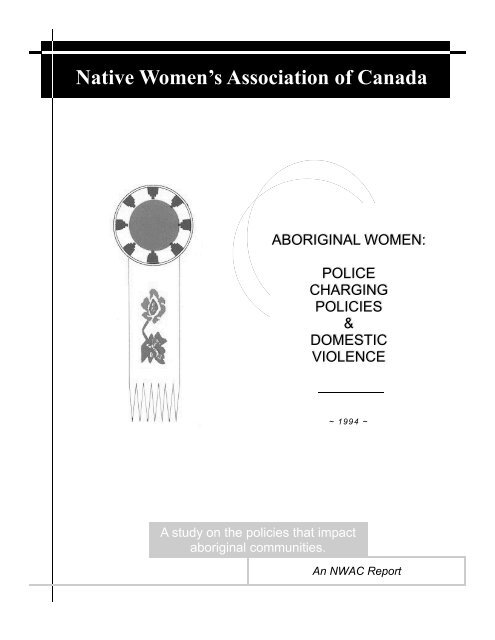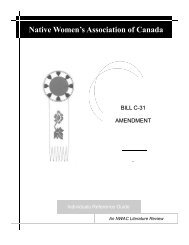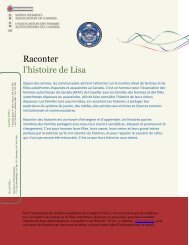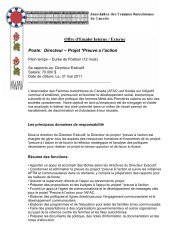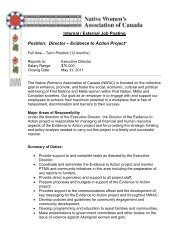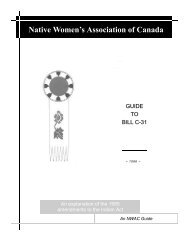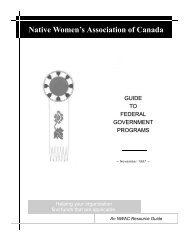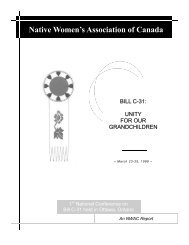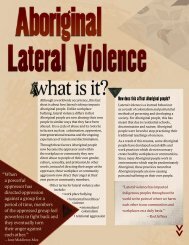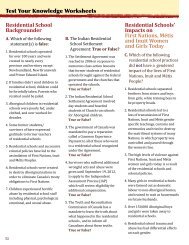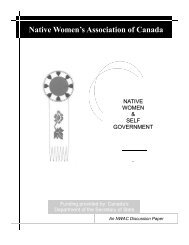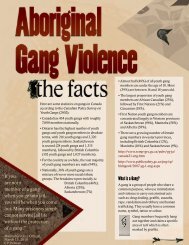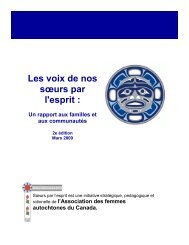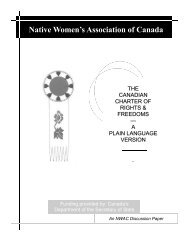POLICE CHARGING POLICIES & DOMESTIC VIOLENCE - Native ...
POLICE CHARGING POLICIES & DOMESTIC VIOLENCE - Native ...
POLICE CHARGING POLICIES & DOMESTIC VIOLENCE - Native ...
- No tags were found...
You also want an ePaper? Increase the reach of your titles
YUMPU automatically turns print PDFs into web optimized ePapers that Google loves.
<strong>Native</strong> Women’s Association of CanadaABORIGINAL WOMEN:<strong>POLICE</strong><strong>CHARGING</strong><strong>POLICIES</strong>&<strong>DOMESTIC</strong><strong>VIOLENCE</strong>~ 1994 ~A study on the policies that impactaboriginal communities.An NWAC Report
Table of Contents1. Poem Excerpt: Death Murmur........................................................42. Introduction.......................................................................................53. Methodology ....................................................................................54. Findings and Recommendations ...................................................65. Conclusion......................................................................................106. Chapter 1 - Mandatory Charging Policies ....................................11a) How the Mandatory Charging Policy is Enforced................................. 11b) Where Evidence Required/Lack of Policy's Enforcement .................... 12c) Failure of the Victim to Follow-Through With Charges......................... 14d) Problem of Discrepancies .................................................................... 14e) Jurisdictional Problems ........................................................................ 15f) Women's Role ...................................................................................... 167. Chapter 2 - Laying Charges: Aboriginal Domestic Violence .....17a) Problems with Reporting Domestic Violence ....................................... 17b) Third Party Responsibility..................................................................... 17c) Problems with Third Party Intervention Police Response .................... 188. Chapter 3 - Reluctance to Report Domestic Violence.................19a) Fear of Retaliation of Spouses............................................................. 19b) Mistrust of the Justice System.............................................................. 20c) Concern for Children's Welfare ............................................................ 20d) Dependence on Spouse's Financial Support ....................................... 20e) Problem with Low Self-Esteem ............................................................ 20f) The Belief System of Aboriginal Peoples ............................................. 21g) Problem with the Failure to Follow Through with the Charges............. 22h) Shame and Stigma Attached to Reporting Spousal Abuse.................. 23i) Problems Living in an Isolated Community .......................................... 23j) The Community Must Take Responsibility........................................... 24Pg. 2
9. Chapter 4 - What Alternatives are Available ................................26a) Alternatives identified ........................................................................... 26b) Access Problems.................................................................................. 27c) Community Involvement and Responsibility ........................................ 29d) Aboriginal Women's Role ..................................................................... 3010. Chapter 5 - Difficulties Encountered by Aboriginal Women....31a) Geographical Problems........................................................................ 31b) Fear of Further Abuse and Removal from the Home and Community...... 32c) No Community Assistance ................................................................... 32d) High Tolerance of Community Violence............................................... 3311. Chapter 6 - Discerning the Role of Tribal Police..........................36a) No Tribal Police Role............................................................................ 36b) Jurisdictional Matters............................................................................ 36c) Cooperative Effort Between Tribal Police and the R.C.M.P................. 37d) Towards Self-Policing........................................................................... 37e) Role of Women..................................................................................... 3812. Chapter 7 - Aboriginal Govmts. Role in Domestic Violence........39a) No Perceived Role for Aboriginal Governments .................................. 39b) Jurisdictional Problems ........................................................................ 39c) Need to Provide and Support Alternative Resources........................... 40d) Need for Aboriginal Women’s Involvement in the Solution .................. 40e) Need for a Cooperative Justice System............................................... 41f) Need for Self-Policing for First Nations ................................................ 42g) Need for the Involvement of Non-Aboriginal Professionals.................. 42h) Alternative Police Commission............................................................. 42Pg. 3
1. Poem Excerpt: Death MurmurBy Jeanette ArmstrongThere are some Indianshanging around Kings hoteland they are dead,preserved in alcohol.It would be neater thoughto kills us all at once.Whole clans and tribescould be dressed and stuffed.Add a fifth floor to the museumto accommodate us.Better yetpile us up like cordwoodin those longhouseswe would be home at lastand it would be good value.(Excerpt from poem published in: Connie Fife, The Colour of Resistance: AContemporary Collection of Writing by Aboriginal Women (Toronto: Sister Vision Press,1993) at 10)Pg. 4
2. IntroductionThe results of this study indicate that mandatory charging policies are not uniformthroughout the various federal, provincial and territorial jurisdictions. As a result,charging policies are not applied uniformly throughout Canada by police officers. Nor dopolice officers have uniform authority to intervene in aboriginal domestic violencesituations. Wife assault within the aboriginal community has reached epidemicproportions. It is imperative that those who work in the criminal justice system recognizethat aboriginal women in domestic violence situations are at a higher risk than womenviolated by strangers. The mandatory charging policy, issued by the Royal CanadianMounted Police, has been in effect in the Northwest Territories since 1981. It has beenin effect in southern Canada since 1984. The assumptions behind the charging policyare: first, the police will lay charges where there are reasonable and probable groundsthat an offence occurred; and, second, the victim should be relieved from laying chargesin domestic violence situations. The Administration of the Criminal Code in Canada isthe responsibility of each province and territory. Each has the jurisdiction pertaining tothe assault provisions used in domestic violence situations. This report will show thatthe national charging policy did not necessarily relieve the victim from bearing theburden of reporting the violence crime, nor did it always aid the police in carrying outtheir mandate. For clarification, the term "<strong>Native</strong> Justice Projects" is a misnomer. Theseparticular projects deal with the administration of Canada's criminal laws, not withenforcing traditional or customary laws in aboriginal communities. While there is onelaw, there are also many law enforcers, <strong>Native</strong> and non-<strong>Native</strong>.3. MethodologyIt is evident, upon review, that little has been written on the mandatory charging policiesin aboriginal domestic violence situations and the impact of those policies upon theaboriginal community .It was necessary, therefore, to obtain data on charging policiesaffecting aboriginal women in domestic violence situations. To collect the data, aquestionnaire on charging policies was sent to 240 <strong>Native</strong> justice projects nationwideincluding Attorneys-General; regional and local police forces; the Royal CanadianMounted Police; court workers; diversion projects; Indian Bands; and <strong>Native</strong>-controlledjustice projects. Set within the framework of seven questions, each question is dividedinto responses received from the <strong>Native</strong> justice projects and those of the police. Thisincludes those police who answered on behalf of "<strong>Native</strong> justice projects". Thecompilation listing <strong>Native</strong> justice projects which were surveyed was obtained from aninventory distributed by the federal Department of Justice. Some of these projects werefunded by the federal Department of Justice and some were funded by provinces. Theonly concern with "<strong>Native</strong> Justice Projects" here is their response to the questionnaireon charging policies by the police in aboriginal domestic violence situations.Pg. 5
4. Findings and Recommendations on Charging Policiesand Aboriginal Domestic ViolenceThere is no specific legislation aimed at criminally penalizing those who abuseaboriginal women and children. The police usually enforce the assault provisions of theCriminal Code and charge [mostly] men who violate women. The assault provisions ofthe Criminal Code, in conjunction with a mandatory charging policy, have notcontributed to a decrease in violence there are reasonable and probable grounds anoffence has been committed against others living in the home. The victim should not berequired to leave the family home.Recommendation 1It is recommended that adequate resources be provided by government to policingagencies, especially those in geographically isolated aboriginal communities.Recommendation 2It is recommended that charges be laid in aboriginal domestic violence situations wherethere are reasonable and probable grounds to believe an offence has been committed.Recommendation 3It is recommended that accused in domestic violence situations be removed from thehome when there are reasonable and probable grounds to believe an offence has beencommitted, and that accused not return to the home until the matter has been resolvedin the criminal justice system by the courts or through a community sentencing process.Recommendation 4It is recommended that charges be dealt with in a timely fashion. Failure to do sopromotes the withdrawing of charges by abused aboriginal women.Recommendation 5It is recommended that the imposition of a non-communication order, as well as theenforcement of 'stalking legislation', be enforced to keep aboriginal women from beingthreatened by the behaviour of third parties acting on behalf of the abuser. For example,relatives or friends of accused men may threaten women who lay charges.Recommendation 6It is recommended that further research be conducted into the reluctance of aboriginalwomen to report domestic violence, including their fear of retaliation, community abuseor non-support, and economic factors.Pg. 6
Recommendation 7The charging policies are necessary to fulfill the obligations of the State to respect thesection 7 [security of the person] rights of victims under the Canadian Charter of Rightsand Freedoms. 1 It is recommended that while the Charter rights of accused must berespected, equal consideration and weight be given to the Charter rights of victims.There is a duty under the Charter to enforce the assault provisions within aboriginalcommunities to the same standard as in other parts of Canada.Recommendation 8It is recommended that enforcement agencies convene a meeting to discuss theproblems arising from the differences in mandatory charging policies across jurisdictions.Recommendation 9It is recommended that where there are tribal police and Band constables that theybenefit from having a uniform charging policy to better protect abused aboriginal womenand other victims.Recommendation 10It is recommended that further research be conducted into eradicating racism in thecriminal justice system, and that amendments be considered to the Criminal Code toaccommodate the Canadian mosaic, for example, cultural defences, communitysanctionedcrime prevention and community punishment, retribution and preservation ofcommunity harmony.Recommendation 11It is recommended that more alternative resources be made available in domesticviolence situations for aboriginal women. For example, community diversion projectsneed to be developed and implemented in the aboriginal context. The development ofthese alternatives may include specifying that family violence is a criminal act.Recommendation 12It is recommended that consideration be given to introducing a Family Violence Actenforceable at the community level.1Elizabeth Sheehy, “Personal Autonomy and the Criminal Law: Emerging issues for Women” (Ottawa: CanadianAdvisory Council on the Status of Women, 1987) at 53.Pg. 7
Recommendation 13It is recommended that police in aboriginal communities enforce a mandatory chargingpolicy which has been developed in consultation with the community. Social controlpolicies at the community level need to be developed and enforced at the communitylevel to prevent violence against women and children.Recommendation 14It is recommended that leadership, elders and women within aboriginal communitiesdevelop and enforce social control policies through local police including the R.C.M.P.,Band Constables, tribal police, peace keepers and Women' s Control Committees.Recommendation 15It is recommended that Indian reserves across Canada and aboriginal women'sorganizations be consulted to develop an agreeable policy on mandatory charging inaboriginal domestic violence situations and that these policies be enforced by theR.C.M.P., tribal police, Band Constables, peace keepers and others responsible for lawand order in aboriginal communities.Recommendation 16It is recommended that aboriginal women and elders be given a meaningful role ineradicating violence on Indian reserves and in aboriginal communities.Recommendation 17It is recommended that aboriginal women be informed of their right to involve police inaboriginal domestic violence situations where communities have not acted to protectwomen in these situations.Recommendation 18It is recommended that there be a standardization of mandatory charging policiesamong various jurisdictions.Recommendation 19It is recommended that federal, provincial and territorial Attorneys-General address theneed to create safe environments for aboriginal women who lay charges in domesticviolence situations including creating halfway houses for violent men; shelters for menremoved from their home for violent behaviour; community carceral facilities for violentmen [and women]; and counselling services to prevent violence.Pg. 8
Recommendation 20It is recommended that there be more dialogue between law enforcers and victims ofdomestic violence to ensure consistency in enforcing criminal assault violations againstwomen, children and elders.Recommendation 21It is recommended that mandatory charging policies be developed in every jurisdictionwith direct consultation with aboriginal women' s organizations. It is recommended thatthe charging policies accommodated the use of aboriginal women's circles at thecommunity level to deal with offenders who commit violent acts within the aboriginalcommunity.Recommendation 22It is recommended that aboriginal women participate with federal, provincial andterritorial agencies in forming mandatory charging policies and setting up alternativeresource centres. There is a need to establish elders' services, women's sentencingcircles, healing lodges, counselling services, sex offender programs and men's supportgroups in all aboriginal communities.Recommendation 23It is recommended that hotlines, radio and cellular phones be made available toaboriginal women and victims of violence in isolated, northern aboriginal communities.Recommendation 24It is recommended that police services be made available to aboriginal women andvictims of violence in isolated, northern aboriginal communities and thatcommunications services to outside police forces be increased including 1-800 numbersand other emergency communications services.Recommendation 25It is recommended that holding cells and temporary shelters be made available in allaboriginal communities where crimes of violence are a regular occurrence and wherenumbers warrant.Recommendation 26It is recommended that healing centres be established in all aboriginal communities with apopulation of 150-plus where crimes of violence are a regular occurrence, and that fundsbe made available for the training of sex offender counsellors and traditional healers.Pg. 9
Recommendation 27It is recommended that healing lodges be established in central locations-isolated, ruraland urban aboriginal communities-to service populations of 2,000 aboriginal persons or500 families. Healing lodges should provide services to children of violence, aboriginalwomen, and aboriginal men.Recommendation 28It is recommended that counselling by traditional aboriginal psychiatrists, psychologists,elders or traditional healers be mandatory treatment for all abusive men, even whenincarcerated.Recommendation 29It is recommended that services in aboriginal languages be made available throughoutthe criminal justice system.5. ConclusionThis study focused on the charging policies of various jurisdictions as they affected theaboriginal community and victims of violence, especially aboriginal women. It is notedthat ninety-two per cent of battered woman cases are not prosecuted. 2 What becameevident were the discrepancies arising from the charging policies and how this impactedupon law enforcement officers dealing with domestic violence in the aboriginal context.It has been found that police are reluctant to enforce the law, especially in charginghusbands for assault unless they receive strict guidelines or instructions. 32Elizabeth Sheehy, "Personal Autonomy and the Criminal Law: Emerging issues for Women" (Ottawa: CanadianAdvisory Council on the Status of Women, 1987) at 53.3Jane W. Ellis, "Prosecutorial Discretion to Charge in Cases of Spousal Assault: A Dialogue" (1984) 75: 1 Journal ofCriminal Law and Criminology 56-102.Pg. 10
6. Chapter 1 - Mandatory Charging PoliciesDo the police automatically lay charges in domestic violence situations in yourcommunity or region?Fifty-two responses fielded the question as to whether the police lay chargesautomatically in domestic violence situations. Although the majority of police respondedaffirmatively to laying charges immediately in domestic violence disputes, their reasonsfor doing so varied. On the whole, police action appeared erratic. Most of therespondents' answers to this question supported the existence of mandatory chargingpolicies and verified their enforcement. Discrepancies were revealed in the policy'seffectiveness across Canada. Contradictions in executing the charging policies becamevisible when the respondents of <strong>Native</strong> justice projects were juxtaposed with those frompolice forces. A gap was found to exist in how the victim reacted in domestic violencesituations. Both parties appeared to experience problems concerning the legalprocedures involved in domestic violence situations. Problems arose from attempting toreport the crime to securing a conviction. Compounding the problem was a mutualdistrust of the criminal justice system when the offender was not convicted.An unidentified individual responding to the survey provided the following description ofthe R.C.M.P. charging policy:"All complaints of domestic violence involving spousal assault should beinvestigated immediately and thoroughly, with the intention of charges being laidor [face] court prosecution, irrespective of whether the assaulted spouse wishedto proceed with charges. An early objective of the investigation should be theprotection of and assistance to victims.This explanation forms the basic assumption the police are to be operating underwhen laying charges. The following report divides the answers of the <strong>Native</strong>Justice Projects from that of the police."a) How the Mandatory Charging Policy is Enforced<strong>Native</strong> Justice ResponseSome respondents stated that the mandatory charging policy is enforced in their regionwhere there are reasonable and probable grounds to believe an offence has occurred.In Manitoba, a "zero tolerance policy" was established in domestic violence situations.The Manitoba policy directive reads:Pg. 11
"Where a police officer has reasonable and probable grounds to believe that ahusband or wife has been assaulted (by their partner), the police have beenrequested to lay the appropriate charge." 4On the one hand, it was asserted that the "decision regarding whether to lay chargesrests with the police." 5 On the other hand, some <strong>Native</strong> justice respondents also statedthat the police, in some areas, required concrete evidence (hospital reports, eye-witnessaccounts, and victim's statements) before enforcing the 'mandatory charging' policy.These varied responses are an indicator of the inconsistencies in laying charges andthey reveal the need for legislation directed at family violence. The mandatory chargingpolicies were intended to alleviate the victim from bearing the burden of laying criminalcharges. All of the hurdles, however, have not been removed.Police ResponseMost policing agencies agree that the mandatory charging policies are enforced onlywhere there are reasonable and probable grounds to believe an offence has occurred. 6Tribal police respondents confirmed that charges were laid as directed by the ManitobaAttorney General. In Winnipeg, Manitoba, for example, charges are laid automatically.The Attorney General of Manitoba's instructions to the police are to lay charges in alldomestic violence situations. In Saskatchewan, one respondent commented that "thepolice and crown prosecutors are directed by the Minister of Justice to lay chargesautomatically in all incidents of domestic assault."This study pertains to the R.C.M.P. mandatory charging policy set out in 1984 south of60 and the Northwest Territories 1981 policy. Most responses from the police verifiedthat the mandatory charging policy was in effect in their area. One individual from NewBrunswick stated that the police often lay charges even when women say they will notgo to court. Similarly, in the Northwest Territories, the R.C.M.P. enforce the policy withthe full support of the N.W.T. Department of Justice. The charging policy specificallystates that it is up to the police to enforce the law. In some jurisdictions, however, theenforcement of the policy depends on evidence to support the charge.b) Where Evidence Required/Lack of Policy's Enforcement<strong>Native</strong> Justice ResponseMost abused aboriginal women experience the discrepancies involved in the policing ofdomestic violence situations. In one community in Alberta, the respondent stated that"statements are taken first and [then] legal papers signed. A warning is given first. If ithappens again, then charges will be laid." Police discretion seems to determine theoutcome, hence, aboriginal women are wary of the justice system protecting them. In4Margaret Wiebe, Women’s Advocacy Program, Winnipeg, Manitoba; Ma Wi Chi Itata Centre, Inc., Winnipeg,Manitoba; Community Legal Education Association, Winnipeg, Manitoba; Legal Aid Manitoba, Winnipeg, Manitoba.5Ibid.6Ibid. and Manitoba Justice; Ontario Solicitor General; R.C.M.P. Winnipeg; R.C.M.P. CharlottetownPg. 12
British Columbia, one respondent noted that domestic assault charges are laid evenwhen the abused woman contested proceeding with the charge. However, it was alsostated that the matter was passed to the Crown attorney to decide if there was enoughevidence to prosecute. It was also reported in Alberta, Saskatchewan and BritishColumbia, that charges for domestic violence disputes are not laid automatically.Where the lack of enforcement of the charging policies is compounded in relation to theperceived evidentiary requirements, this negates the practicality of the policy's intent.The provisions of the mandatory charging policy seem contradictory, rather thancomplementary, to the Criminal Code assault provisions. Respondents also contendedthat evidentiary problems arise when aboriginal women refuse to testify in court, providea statement, and then withdraw their complaints.There are various other reasons why the charging policy is not enforced. The effect ofthe mandatory charging policy is further diminished when there is delayed policeresponse in a domestic violence crisis. The delay in police response can be attributed toany number of reasons. In isolated communities it is difficult for police to respondimmediately if the only means of transportation is by air or boat. For aboriginal womenthe delay may be due to the lack of a telephone, or other means of communication. Itwas suggested by a respondent from Nova Scotia that even in urban centres there canbe a delayed police reaction. The police may also delay responding if the woman "has along history of dropping the charges. She may be required to personally lay the chargerather than have the police follow through with the charging policy." In some isolatedcommunities, there are no police services available.Police ResponseIn many situations, the mandatory charging policies do not come into effect until thevictim provides evidentiary proof to police by laying an information. One respondentfrom the Akwesasne Mohawk police stated that "charges will be laid automatically ifthere is sufficient evidence and reliability on the part of the victim to testify." Without aformal complaint, some law enforcers were hesitant to lay charges. Some also requiredthe additional validation of witness testimony. The respondents also stated that"charges were not laid automatically because it depended upon the situation." Somemembers of the R.C.M.P. want "to be able to prove the facts" before laying charges.These facts include the determination of extenuating circumstances, assessing whethera witness is hostile, gathering physical evidence, and acquiring witness statements.One respondent noted that police will lay charges "when there is evidence of a violationof the Criminal Code, for example, threats or assault." In Campbell River, BritishColumbia, for example, the police required substantiating evidence. Though the legalauthorities have a strong policy supporting the prosecution of offenders in domesticviolence situations there is still some hesitancy in exercising that mandate. This couldbe due to the police having to balance the evidentiary requirements of the CriminalCode with the rights of accused under the Canadian Charter of Rights and Freedoms.Pg. 13
The following examples of charging discrepancies are evidence that the mandatorycharging policies are not followed consistently across the country. In Newfoundland, theR.C.M.P. will automatically lay charges, but it "cannot be withdrawn without thecomplainant wishing the same." In Quebec, the police also do not lay chargesautomatically where they feel the need to establish factual evidence first. In one Ontarioregion, the police lay domestic assault charges 'only' where they can establishreasonable and probable grounds to do so. In Yellowknife, Northwest Territories, onerespondent stated the onus is on the victim to lay charges 'if' she wishes. Charges arenot laid automatically, in some instances, because the investigating police officer mightwant to collect evidence, take the offender or victim in for questioning, provide a coolingoff period, or allow the victim the prerogative of rescinding the charge.c) Failure of the Victim to Follow-Through With Charges<strong>Native</strong> Justice ResponseAs stated, the mandatory charging policies were intended to relieve the victims ofviolence from laying charges in domestic violence situations. Perhaps the biggestchallenge for an aboriginal female victim, however, is to follow-through once a chargehas been lain. A respondent from Bums Lake, British Columbia, noted that women "whorefuse to give statements, or appear as witnesses...may result in the case not goingahead." A legal writer suggested that the apprehensions of aboriginal women in layingcharges stems from a "lack of public knowledge within the aboriginal community thatspousal abuse and domestic violence are crimes."Failure to follow-through with the assault charges also might be affected by suchvariables as to whether the accused is a first time offender, the victim's sympathy for theaccused, or whether alcohol was a factor. Every domestic violence situation is different,but the victim's safety and that of her family are paramount.Police ResponseIn Alberta, it was reported that charges are usually laid if the victim cooperated, followedthrough with the charging process, and the evidential circumstances of the assault wereproved. Many law enforcers felt they needed the full cooperation of the victim to securethe conviction of the offender. Without concrete evidence to make the charges hold upin court, some police, even with a mandatory charging policy, do not seem confident inthe system. This seeming lack of confidence in the criminal justice system, on the partof police and the victims, demonstrates the ineffectiveness of the mandatory chargingpolicies. The mandatory charging policies fail if the burden of laying charges remainswith the victim and not with law enforcers.d) Problem of Discrepancies<strong>Native</strong> Justice ResponsePg. 14
Discrepancies concerning the application of the mandatory charging policies appearthroughout the charging process. There is a long history of discontent and mistrustbetween the R.C.M.P. and the aboriginal peoples in this country.In [1972 in] Saskatchewan... Indians [made] up 10 per cent of the population but 50per cent of the jail and prison population. The figures for women prisoners inSaskatchewan [were] even more disproportionate. Charges such as drunkenness orcreating a disturbance, where there is leeway for discretion on the part of the officeras to whether or not he makes an arrest, are common among Indians and Métis.This tension contributes to one of many reasons for discrepancies in reporting assaultcharges by aboriginal women, and the varying reactions from law enforcers. Furtherinquiry would address other contingencies to the issue of investigating aboriginaldomestic violence situations. While the respondents of the <strong>Native</strong> Justice Projectsanswered an aspect of the aboriginal woman's view, their answers did not constituteenough information for proper analysis. Further explication of the reasons why there areso many discrepancies in the charging policies and their effect upon aboriginal womenand law enforcers will be revealed in the following chapters.Police ResponseThe results of the study demonstrated some law enforcers lack certainty inimplementing the mandatory charging policies. Many respondents wavered in theiranswers as to whether the police in their area automatically laid charges. Some said,"not always" or "in most cases" or "as far as I know" to "technically the police aresupposed to lay charges." The candour of the responses revealed that a substantialamount of discretion is exercised by the police.e) Jurisdictional Problems<strong>Native</strong> Justice ResponseJurisdictional problems also contribute to delayed police reaction in aboriginal domesticviolence disputes. One respondent suggested that there was "more variation inadherence among the municipal police departments" than the R.C.M.P. The negativitygenerated from the discrepancies involving mandatory charging policies and practicesamong the federal, provincial, or police in domestic violence situation requires furtherstudy. It was suggested by one respondent that "few monitoring studies" have beenconducted.Police ResponseThe issue of reviewing the charging policies and practices of federal, provincial, andmunicipal police are required to get a total picture of the nature of family violence. Thisissue was not raised as a concern pertaining to the police respondents of this survey. Itdid come up, however, in relation to those respondents of the <strong>Native</strong> Justice Projects.Pg. 15
f) Women's RoleThe majority of aboriginal women are ill-informed of their legal rights in a domesticviolence situation and the availability of legal aid. Sometimes, the effect of mandatorycharging policies disempowers aboriginal women from taking responsibility for their owndecisions. When the police remove the victim from the home for her safety, the questionarises as to whom is being protected? The victim? The offender? The security of thevictim should be the first priority. 77Contributor to the chapter include Margaret Wiebe, Women’s Advocacy Program, Winnipeg, Manitoba; Ma Wawi WiChi Itata Centre Inc., Winnipeg, Manitoba; Community Legal Education Association, Winnipeg, Manitoba; Legal AidManitoba, Winnipeg, Manitoba; Manitoba Justice; Charlottetown, PEI RCMP; Ontario Solicitor General; DakotaOjibway Tribal Council, Brandon, Manitoba; Judy Bartlett, Victim/Witness Assistance Program, Burns Lake, B.C.;Happy Valley RCMP; Chief Coroner, GNWT; Six Nations Police; Gitksan-Wewt’suwet’en Education Society,Hazelton, B.C.; Public Legal Education Association, Whitehorse, Yukon Territory; Labrador Legal Services; MicMac<strong>Native</strong> Friendship Centre; Council for Yukon Indians; Akwesasne Mohawk Police; Government of the NorthwestTerritories; <strong>Native</strong> Para-judicial Services of Quebec; Justice Canada; Siksika Nations Police Services; Justice NewBrunswick; Milton, Nfld. RCMP; Yellowknife RCMP; and Dalhousie University, Halifax, N.S.Pg. 16
c) Problems with Third Party Intervention Police Response"It was a neighbour of mine who called the police. When the police came in it wasout of my hands totally. My whole life changed. All of a sudden I wasn't allowedto make any decisions. He [police] didn’t have discretion… Officers are to chargeeverybody no matter what. So, the officer did what he was told and destroyed mylife without even asking me… They were really upset when I refused to go tocourt. The process of court and jail is not a solution for the problem..."This case scenario presents the dilemma of third party intervention where the womaninvolved resented such an invasion of privacy.In this case, the law enforcers fully executed the mandatory charging policy withoutrelying on police discretion. In the Northwest Territories, the police respond to ThirdParty calls concerning domestic violence when it is reported by nurses and socialworkers. Prince Edward Island police responded that if the assault is 'in progress',police will respond immediately. If the Third Party report is made after the assault, policewill question the alleged victim.It can be surmised that the police exercise caution when responding to Third Partycomplaints due to the probability of dealing with unreliable or hostile witnesses. When aThird Party does report a domestic violence situation, one respondent found that "RoyalCanadian Mounted Police will then take the first step in talking to the victim". Goodrapport between the Royal Canadian Mounted Police and the victim is very important.One unidentified individual provided this insight:"Either the abused party or some other person with knowledge that a crime ofdomestic violence has occurred can call the police, but the police must havereasonable and probable grounds before a charge can be laid, and often suchgrounds only exist if the abused party will speak to police."Probable reasons for Third Party intervention ranged from overcoming language orcultural barriers, no telephone in abuser's or victim's home to victim fear to report.Although the onus can shift from the victim to a Third party, the main problem for policestems from ascertaining the reliability of witnesses, gathering evidence, and having thevictim follow-through with charges once they are laid. 88Contributors to the chapter include: Ontario Solicitor General; RCMP Ottawa; <strong>Native</strong> para-judicial Services of Quebec;Government of the Northwest Territories; RCMP Winnipeg; Arctic PLEI; Brandon City Police; Judge Coutu; ConneRiver; Saskatchewan Justice; Labrador RCMP; NWT Social Services; Ministry of Community and Social Services,Windsor, Ontario; <strong>Native</strong> Clan Organization; RCMP Campbell River; Ma Mawi Wi Chi Itata Centre, Winnipeg,Manitoba; Happy Valley RCMP; Chief Coroner, Department of Justice, NWT; RCMP Burnaby; University ofSaskatchewan, Saskatoon, Saskatchewan; Hey-way'-noqu' Healing Circle for Addictions Society, Vancouver, B.C.;RCMP Regina, Saskatchewan; Akwesasne Police; Six Nations Police; Siksika Nation Police Services; Gitksan-Wet'suwet'en Education Society, Hazelton, B.C.; Tony Mandamin, Alberta; Charlottetown, P.E.I. RCMP.Pg. 18
8. Chapter 3 - Reluctance To Report Aboriginal DomesticViolenceAre Aboriginal women reluctant to lay charges if their husbands or boyfriendsbeat them? Explain briefly.Forty-seven respondents provided valuable insight concerning the reluctance ofaboriginal women to lay charges if their spouse or boyfriend beat them. Respondentsfrom the police and <strong>Native</strong> Justice Projects stated that there were a variety of reasonspreventing aboriginal women from reporting violent actions committed against them.After analyzing the results, this question served to expose some of the weaknessesinherent in the mandatory charging policies.a) Fear of Retaliation of Spouses<strong>Native</strong> Justice ResponseMost respondents reported that aboriginal women may not follow through with chargesfor fear of retaliation and because there has never been anything done before to stopmale violence in the community. Aboriginal women are intimidated by their spouse or donot want him to go to jail. Aboriginal women also feel intimidated and at further risk oncethe charge has been laid. Aboriginal women are also concerned about what will happenif the abuser does jail time, and then returns home. The main reason for this fear is thatthe violence will get worse especially if the abuser is not incarcerated and is out on thestreet.Police ResponseIn the northern communities, aboriginal women are afraid to report spousal assaults tothe police. Reasons behind this are that they have very little support from thecommunity as a whole and that they have very little support from the community.Victims also have limited resources. Fear of reprisal from the spouse is also a mainconcern. Sometimes, there is pressure from the community or spousal threats andpressure which makes aboriginal women reluctant to call police in family violencesituations. Akwesasne reported that aboriginal women are reluctant to involve policebecause of embarrassment and possible repercussions. The woman also finds that it issocially unacceptable to have charges laid against a spouse or live-in boyfriend. Evenwhere the abuse is reported by a Third Party, police must still interview the woman andshe will be asked to testify against the accused. There may be, however, additionalcultural barriers facing aboriginal women causing them to not report assaultivebehaviour. There are many dynamics involved in these situations and non-reporting iscommon for several reasons: the victim's fear of retaliation, protection of the accused,and the belief that nothing will be done as a result of reporting the incident.Pg. 19
) Mistrust of the Justice System<strong>Native</strong> Justice ResponseThe <strong>Native</strong> Justice respondents reported that aboriginal women expressed "mistrust ofthe non-<strong>Native</strong> justice system." Reluctance on the women's part was shared by theRoyal Canadian Mounted Police even when hospitalization was required. Aboriginalwomen in these situations may be intimidated by the criminal justice system, or just beafraid. As well, aboriginal women may have a greater distrust of the justice systembecause of its negative impact on aboriginal peoples over the years.Police ResponseThe police respondents reported that within the aboriginal community this distrust of thenon-<strong>Native</strong> justice system may be a factor in the silencing of aboriginal victims.c) Concern for Children's Welfare<strong>Native</strong> Justice ResponseAn unidentified respondent stated that aboriginal women may be too scared to proceedwith laying criminal charges. They worry about what will happen to their children. Who isgoing to support the family? They worry whether they may be threatened by theirspouse. Some aboriginal women do not trust the police.d) Dependence on Spouse's Financial SupportPolice ResponseAboriginal women are reluctant to call police because they have no income or the familymember wants help. She will call if beatings persist. Most women who are abused suffernumerous violent incidents over a prolonged period of time before involving the police.Victims need to know that they may lay an information privately before a justice of thepeace. One individual stated that the reluctance of aboriginal women to lay chargeswhen their spouses beat them could also stem from the victim' s emotional dependenceon the spouse. There may also be particular cultural factors which make aboriginalwomen reluctant to follow through on charges, or practical factors. For example, thevictim may rely totally on the abuser for financial support, income, or livingarrangements in the community.e) Problem with Low Self-Esteem<strong>Native</strong> Justice ResponseThe reluctance of aboriginal women to report their abusive husbands ran the gamut ofuncertainty, shame inability to handle their own problems, no where to go or lonelinessor aloneness. Abused aboriginal women in these situations suffer low self-esteem. Theymay also fear the future if the crime is reported to the police.Pg. 20
Other factors included "[feeling] intimidated and afraid to lay charges believing they arestill in love or that it will not happen again." Sometimes, aboriginal women just feel sorryfor the accused even after a beating. This empathy for the accused also may result inrequesting that the charges be dropped because it takes a certain amount of stamina tosee the charging process to the end. Victims rarely have the strength to follow throughwith the reporting procedure. There are many abused aboriginal women who think theydeserve the violence.f) The Belief System of Aboriginal Peoples<strong>Native</strong> Justice ResponseCommunity beliefs and expectations are also a factor in keeping aboriginal women inabusive situations. The woman is expected to resolve her marriage problems within thefamily and not go to outsiders. Abused women feel ashamed that they cannot solvetheir own problems. The aboriginal woman has no where to go. In the vast majority ofcases, there are no women's shelters in aboriginal communities. Research on violenceagainst aboriginal women shows that they may be victims of thirty to forty abusivesituations before making a report to the police. Some women believe they deserveabusive treatment. One woman said it is customary for a husband to beat his wife if shedoes not obey him. In most aboriginal communities, there is no "safe house" for victimsfor abuse. Aboriginal women may not follow through once charges have been laidbecause the work things out within the community on their own. They may takeadvantage of a victim and offender reconciliation process in the community, although itsexistence and use if rare.Police ResponseOne police respondent purported that: Aboriginal people usually work things outamongst themselves. For example, by utilizing the victim and offender reconciliationconcept. This concept is supported by one respondent:"Often, [abused aboriginal women] are reluctant. Their society pressures them tokeep the family together at all costs. Or they do not see any chance of anychanges. She may fear repercussions or loss of her children. Where there is areconciliation the legal machinery grinds to a halt when the victim fails to appearin court, or attempts to have the charges withdrawn or dropped. Sometimes, theaboriginal woman is blamed for the violence. A respondent from Quebec statedthat he abused aboriginal woman may try to resolve the matter herself beforeinvolving the police. She will call if beatings persist."Pg. 21
g) Problem with the Failure to Follow Through with the Charges<strong>Native</strong> Justice ResponseThere are many reasons why aboriginal women will not support or follow-through withcharges of spousal abuse. The lack of self-esteem, the high tolerance for violencewithin the aboriginal community, the lack of police services in many communities, andthe absence of public education about legal rights contribute to sustained violenceagainst aboriginal women. Crown prosecutors have said that often aboriginal womenwill want to withdraw the charges before going to court. One reason cited is that it isdifficult for aboriginal women to lay charges against a man she is still living with, andshe may want to continue the relationship.One respondent said aboriginal women are reluctant to follow through with chargesbecause of pressure put upon them by their Societies [communities] to keep the familytogether at all costs. Or, the woman may not see any chance of change in her situation.Also she may fear repercussions or loss of her children. One of the major difficultiesfaced by law enforcers dealing with aboriginal women is their reluctance to testifyagainst the abuser once a charge has been laid. In this respect, aboriginal women reactno differently than non-aboriginal women.Police ResponseAlmost all respondents agreed that most abused women are reluctant to carry throughwith assault charges against their husband or live-in boyfriend who beats them. This isparticularly true when a successful prosecution relies on her testimony. The reluctancealso depends upon the woman and man involved. Some respondents suggestedaboriginal women are no more reluctant than non-Aboriginal women to report abuseand follow through on charges. There are no studies to suggest any other conclusion.The Royal Canadian Mounted Police in Ottawa found that non-aboriginal women showa similar reluctance to report abuse:"Many women of all cultural groups are at times reluctant to involve the police, fora variety of reasons. It is difficult to separate aboriginal women except to say insome areas there is considerable mistrust of the non-<strong>Native</strong> justice system whichno doubt influences such reports." 9Police respondents agree that one of their major difficulties in dealing with aboriginalwomen in domestic violence disputes is the women's reluctance to testify against theabuser once a charge has been laid. As one respondent noted:"I find that Aboriginal women are not reluctant in laying charges against theirhusbands who beat them. The problem which I find is when they have to appear incourt and testify against their husband, it creates problems at that point wherewomen feel that they should back out of going through with the assault charges." 109Ottawa RCMP; Solicitor General Canada.10Brandon City Police.Pg. 22
This situation is allayed somewhat when sufficient evidence of an assault has beengathered. It is also helpful when police can testify instead of the victim. One aboriginalpolice force stated:"There are a lot of incidents where we lay charges of assault on the husband andthe wife will not appear in court. Consequently, charges will be stayed or dropped."If intoxicants are involved, abused aboriginal women may later want the chargesdropped for a number of reasons, including the fear of retaliation, the date of the trial, orbecause there are too many adjournments. Sometimes, the legal process impedes itsown function of a speedy trial with too "many adjournments."h) Shame and Stigma Attached to Reporting Spousal Abuse<strong>Native</strong> Justice ResponseThe environment in which aboriginal women live and their segregated living situation inisolated, rural and urban aboriginal communities also contributes to their reluctanceand/or ability to call police. In some cases, a woman's reluctance was based on the"stigma attached with a wife reporting a spousal assault" and the ensuingembarrassment.Police ResponseBecause of the small communities in which they live, aboriginal women fear beingbeaten again. If the husband goes to jail, there will be no family income. There is astigma attached to an aboriginal woman who reports her husband for abuse, particularlyif he goes to jail.i) Problems Living in an Isolated Community<strong>Native</strong> Justice ResponseWhen aboriginal communities politically and silently support abusive men they alsoostracize aboriginal women and wives who lay the charges. The abused woman has nochoice then but to leave her community. If the woman does not want to leave hercommunity, she must ask that the charges be dropped. This is particularly true in small,isolated and remote communities. This problem is made worse when these communitiesdepend upon circuit courts which come only periodically.Pg. 23
j) The Community Must Take Responsibility<strong>Native</strong> Justice ResponseCommunity initiatives in the field of family violence are a fairly recent phenomenon withfederal and provincial funding available only over the past few years. It may take timefor other communities to reach the stage where aboriginal women feel they can havecharges laid without retaliation. In some instances, aboriginal women are changing. It isbeing reported that more abused aboriginal women in certain areas are becoming lessreluctant to call police and are following through with charges in abusive situations. Onerespondent noted:"There is a lot of under reporting especially in the municipal jurisdictions. At thesame time, there is a much higher rate of peace bonds being sought by nativewomen than by other women in the neighbouring 'white' areas this suggestsnative women do lay charges even if most are subsequently withdrawn even atthe peace bond level. And of course there is a much higher rate of convictions asre personal violence, chiefly assault, something which again suggests thatcharges are being laid." 11This may be the result of being more informed about the criminal aspect of domesticviolence, as well as women encouraging other women to report this crime. Increases inreporting violent crimes against women will occur when women see the perpetratorprosecuted.Within the community, there is a need for a change in the collective attitude towardviolence against women. Once this change takes place, aboriginal women can morefreely take control of their lives and work with police to lay charges in abusive situations."Women will find the strength to come forward if they feel that the attitude in thecommunity supports them."Nurses, doctors, clergy, business people, government workers, teachers, and othersliving near or in aboriginal communities generally can take responsibility to call thepolice in domestic violence situations. One study noted:"At the hospital, we could start calling the police automatically. We could alsostart documenting the scope of the problem. Maybe we could broadcast thescope of the problem on the FM [radio] so the community is aware of how often itis happening here.” 12Abused aboriginal women need to recognize that they have alternatives. Where femaleaboriginal police officers can provide assistance to abused women, there is likely to bean increase in the laying of charges and seeing the legal process through. As was notedin the Kuujjuaq study:11Don Clairmont, Sociology, Dalhousie University, Halifax, Nova Scotia.12Kuujuuaq at 45.Pg. 24
"I think it is time to start doing things about family violence in the community now.People are starting to talk about it. Women are starting to charge their husbandsor boyfriends. It is something that has started to come out. A few years ago theproblem did not come out. People are more open about it now than they werebefore." 13When abused women see that there is community support to end domestic violence,they may be less afraid to lay charges. 1413Ibid. at 43.14Ibid. at 48. Contributors to this chapter include: Chief Coroner, GNWT; St. Mary’s Band Administration; Council ofYukon Indians; Hey-Way’noqu’ Healing Circle for Addictions Society, Vancouver, B.C.; Kuujjuaq Study; Ma Mawi Wi ChiItata Centre Inc., Winnipeg, Manitoba; RCMP Yellowknife, N.W.T.; Siksika Nation Police Force, Gleichen, Alberta;Akwesane Police; Judge Coutu, Quebec; RCMP Charlottetown, P.E.I.; <strong>Native</strong> Women’s Transition Centre Inc., Winnipeg,Manitoba; RCMP Ottawa; Gitksan-Wet’suwet’en Education Society, Hazelton, B.C.; Department of Sociology, University ofSaskatchewan, Saskatchewan; Nemaska Band Council; Ontario Ministry of Solicitor General; Manitoba Justice; Governmentof Northwest Territories [Pepper]; Ontario <strong>Native</strong> Women’s Association; Arctic PLEI; Victim/Witness Assistance Program,Burns Lake, B.C.; RCMP Winnipeg; Six Nations Police, Ohsweken, Ontario; RCMP Milltown, Newfoundland; RCMPHappy Valley; RCMP Campbell River; New Brunswick Justice; RCMP Chilliwack, B.C.; Solicitor General Canada;Brandon City Police; RCMP Winnipeg; Dakoto-Ojibway Tribal Council Police, Brandon, Manitoba; RCMP Regina;Ministry of Community and Social Services, Windsor, Ontario; Department of Justice Canada, Yellowknife, N.W.T.;Mediation Services, Winnipeg, Manitoba; Legal Aid Manitoba; Don Clairmont, Sociology, Dalhousie University, Halifax,N.S.Pg. 25
9. Chapter 4 - What Alternatives Are Available For AbusedAboriginal WomenAre there alternatives within the community or region available to aboriginalwomen in violent situations?Forty nine respondents provided input as to whether there were alternatives within theircommunity or region available to aboriginal women in violent situations. They wereasked to identify them, for example, elder circles, holistic healing and so on. Feedbackfrom the survey indicated that there were a variety of alternatives for women in violentsituations. Although alternative resource centres are available they appear to be few innumber and access to them is a greater problem.a) Alternatives Identified<strong>Native</strong> Justice ResponseThe <strong>Native</strong> Justice respondents stated that, in most cases, police services are notavailable to aboriginal women in remote communities. There are also no alternativeresources for abused aboriginal women seeking refuge from the offender. What isespecially lacking are aboriginally designed traditional alternative resources. Somecommunities have initiated women's circles, talking circles, healing circles or Elders'circles for used by female victims, and increasingly, for abusive men. Elders alsoprovide advice concerning abused women where they are represented on Boards oftransition houses or shelters. Women need immediate protection in violent situations.Shelters should be available in communities either to house abusive men, or victims.Some women's shelters are now available in a few aboriginal communities. Aboriginalwomen prefer to have "safe houses" available in their community or closer to home.Police responseThe police respondents reported that the victim is usually made aware of women'sshelters and is removed where the husband or boyfriend is arrested and expected to bereleased. Winnipeg respondents identified crisis lines, women's shelters, transitionhouses, and social service agencies offering group and individual counselling. All employaboriginal workers and incorporate cultural factors and aboriginal healing principles.Generally, no aboriginal community alternatives are available, but there is a transitionhouse for aboriginal women in Fredericton, New Brunswick. There are also aboriginalwomen's shelters in Kuujjuaq and Chisasibi, Quebec. A respondent from Akwesasnestated that abused women are removed from the home and taken to a shelter "in[Mohawk] territory."Pg. 26
Where the respondents did not provide alternative resource information, they did offerpertinent feedback. Some mentioned that the Band leadership in their area were beingcriticized for "being unresponsive to women victims." Others stated that tentative plansto set up "a community-based model for dealing with family violence was beingconsidered." It appears that some aboriginal communities are taking the initiative andresponsibility for resolving domestic violence."Most chiefs and council members are male and often exhibit bias in favour of themale partner in a domestic abuse situation. This can effectively chase the womanfrom her home and community. The unwillingness of chiefs and councils toaddress the plight of women and children suffering abuse at the hands ofhusbands and fathers is quite alarming. We are concerned enough about it tostate that we believe that the failure of Aboriginal government leaders to deal atall with the problem of domestic abuse is unconscionable. We believe that thereis a heavy responsibility on Aboriginal leaders to recognize the significance of theproblem within their own communities. They must begin to recognize, as well,how much their silence and failure to act actually contribute to the problem.Aboriginal leaders must speak out against abuse within their communities to theirown community members, and they must take steps within their own spheres ofcommunity influence to assist the true victims. Women and children who reportabuse should never feel they have to leave their communities in order to feelsafe. Aboriginal communities and their leaders must do what is possible to makethe home communities of abused women and children havens from abuse. Theproblem of abuse is dealt with presently by women either staying on the reservesand putting up with the abuse, or leaving their communities to live elsewhere, justto escape from it. It is clear, however, that most would prefer to stay in theirhome communities if they could be protected. 15 "b) Access Problems<strong>Native</strong> Justice ResponseThe lack of safe homes or shelters within the communities presents a barrier for those whofear retaliation from the offender. A respondent from Yellowknife stated: "Most communitiesdo not have programs or services addressing domestic violence due to the lack ofresources human and financial." The apparent lack of funding hampers any progress intrying to offer women and children the protection they need. Sometimes, women who leaveabusive men may have to leave their community. Generally, women's shelters are onlyavailable outside the aboriginal community. When aboriginal women have to accesswomen’s shelters outside their community this adds to their stress. The shelters providetemporary housing and sometimes counselling for women and children victims. "Safe"houses are also available to aboriginal women, but they are located outside the aboriginalcommunity. Usually, "safe" houses are located in urban centres. The urban safe house maynot be considered culturally sensitive, including if it is staffed with non-aboriginal workers.15A.C. Hamilton and C. M. Sinclair, Report of the Aboriginal Justice Inquiry of Manitoba: The Justice System andAboriginal People, volume 1 (Winnipeg: Province of Manitoba, 1991) at 485.Pg. 27
The Northwest Territories' respondents reported that ten of the fifty-seven communitieshave women's shelters. They offer a wide range of services such as counselling,support and referrals. However, victims can only gain access to these shelters inYellowknife. Some respondents stated that even facilities available in urban centres aretoo small to accommodate abused aboriginal women and their children. In Labrador,urban-based "safe" houses are available by air from all communities except one.Other access problems facing battered aboriginal women in a crisis situation include thelocation of women's shelters in large urban centres. This leaves abused women noalternative but to leave their aboriginal community. In Ontario, one respondent noted thatthere were aboriginal - specific alternatives, but stated that "access to these servicesvaries widely." One respondent noted that there are safe houses for women but not forthe husband.Police ResponseOver the past few years, some efforts have been made by communities and the policeto develop alternatives for women in abusive situations. Access to service varies.Some of these alternatives include: women's shelters, "safe" houses, transitionhouses, sexual assault centres, counselling, family counselling, social services, <strong>Native</strong>women's associations and healing circles. The Royal Canadian Mounted Police havealso developed Victim's Services units. Police respondents reported a variety ofproblems concerning access to alternative resources for aboriginal women. Someoutlying communities have to access urban-based women's resource centres. TheRoyal Canadian Mounted Police report there are shelters and counsellors availablewithin a reasonable distance of isolated communities. There is no women's shelter atSiksika, but abused women can access a shelter in Calgary. The woman may not beable to leave a violent situation because of the cost of travel.Some aboriginal women and law enforcement agencies have noted that shelters forabused women are not available in most aboriginal communities. They are locatedoutside the aboriginal community and the policy of removal of victims leaves the accusedin the home. Often the accused remained in the community with access to the victim. Theremoval of women and children from the home is an option. The woman victim will beremoved from the home if she is in danger, or if the husband is not arrested. This kind ofpolicy needs to be reviewed. Why make the victim homeless in addition to being abused?Some police are presently looking at removing the offender from the home instead of thevictim(s). Also, if the evidence warrants it, then the problem of having the abused womanfeel re- victimized by removal from the home is eliminated.The problem of accessing alternative resources for handling aboriginal spousal abuseand family violence may be hindered by the charging policies. Some communities,however, have discussed sentencing diversion projects or measures to involve thecommunity members more in eradicating family violence. The charging policies,however, require that all cases be brought to court if known to the police. Some of thediscussions to control family violence have lead to the establishment of drug andalcohol abuse centres.Pg. 28
In some cases there are no alternatives for women victims of spousal abuse such aselder involvement or healing circles. One respondent suggested aboriginal women seethe Indian Act Band Councillors for assistance, as an alternative.c) Community Involvement and Responsibility<strong>Native</strong> Justice ResponseCommunities need to become involved in a consciousness raising effort to end violenceagainst women and children. One major difficulty which hinders community involvementis lack of resources to develop holistic healing alternatives. A respondent from NovaScotia reported:"Increasingly there are alternatives because of the development of Mi'kmaqFamily Services and most recently the development of transition and counsellinghomes and programs. One of these latter has just become operative on CapeBreton (on the Whycocomagh reserve) and another is supposed to come onstream within a year on the mainland (on the Millbrook reserve). As part of thelatter development programs... holistic healing is being considered." 16One respondent suggested that abusive men should attend healing circles like thewomen. Part of the healing process must involve realizing his own role in the violenceagainst his spouse.The aboriginal community should try to accommodate women in violent situations. Theavailability of an alternative resource for women in these situations is critical at allstages of domestic violence, whether as a preventative program or for follow-upconsultation. Most respondents felt that establishing aboriginal-oriented shelters locatedwithin the community or region would greatly benefit aboriginal women in domesticviolence situations.It has been suggested that community councils on family violence be established inaboriginal communities to replace non-aboriginal justice systems. This proposal wouldmean that no charges would be laid by police. It also means the aboriginal communitygovernment would make the offender responsible for his actions."There has to be enough autonomy for a community council to make the manknow that this is what he will have to go through. There should be no other placefor the man to go if he does not accept the decision of his community. He needsto know he will not be accepted in his community if he is violent." 1716Don Clairmont, Sociology, Dalhousie University, Halifax, N.S.17Kuujjuaq (Quebec) at 36.Pg. 29
Men with violent tendencies must decide to end the abuse of women and children. "Menhave to control themselves." The <strong>Native</strong> justice respondents found that while theseinitiatives are helpful to victims of crime, what is more urgently required are initiatives formen which are preventative rather than punitive. In the Northwest Territories, onerespondent felt that abusive behaviour that is learned can be unlearned. The crux of theabusive situation is that aboriginal women will not use alternatives to domestic violenceif they have little knowledge about the criminality of spousal abuse.Counselling services need to be made available within aboriginal communities. "Thisincludes counselling for everyone: victims, offenders, children, adults, families…Counselling as an alternative to court." Abused aboriginal women victims need to bemade aware of their legal rights in domestic violence situations. "Victims have to bemade aware that abuse is not acceptable, [and] that they don't deserve what happens tothem." The cycle of abuse can be prevented with the development and implementationof a community education process on domestic violence. Some other service needsbrought forward in the survey called for victim advocacy centres, rape crisis centres,crisis lines, the re-examination of priorities and s funding practices of agencies, andmediation or reconciliation services as an alternative to present practices.Indian Act governments and the entire aboriginal community can begin takingresponsibility for eradicating domestic violence. But this will only occur when theaboriginal community adopts a zero-tolerance policy and enforces it against violentmen. One respondent noted that increasingly there are shelters being built in aboriginalcommunities. Indian Act governments are receiving a lot of "flak" for being unresponsiveto women victims. Some Indian bands are giving support to setting up shelters in nearbynon-aboriginal communities. Indian Bands also provide family care workers and someIndian Bands have healing circles. Aboriginal women should be encouraged to organizethemselves against violence. This was accomplished by one women's group inSaskatchewan called the Women's Aboriginal Coalition Against Domestic Violence.d) Aboriginal Women's Role<strong>Native</strong> ResponseAbused aboriginal women in violent situations can also make a choice to change theirlifestyle. Aboriginal women can decide to help themselves by leaving violent situations.A friend or relative can assist women who are afraid to leave. Where alcohol and drugabuse by women contribute to family violence, her spouse can give her support to seekrehabilitation. If possible, she may have to leave for a few months to take in-housetreatment, or take a 28-day program for drug and alcohol abuse. 1818Contributors to the chapter include: Conne River, Nfld.; MicMac <strong>Native</strong> Friendship Centre, Halifax, N.S.; <strong>Native</strong>Women's Transition Centre Inc., Winnipeg, Manitoba; RCMP Ottawa; Gitksan-Wet'suwet'en Education Society,Hazelton, B.C.; Arctic PLEI; Aispich Chakwan; Justice Manitoba; Justice New Brunswick; Judge Coutu, Quebec;Akwesasne Mohawk Police; Kuujjuaq; Ministry of Community and Social Services, Windsor, Ontario; RCMPWinnipeg; Chief Coroner, GNWT; Labrador Legal Services, Happy Valley-Goose Bay, Labrador; Hey-way'-noqu'Healing Circle for Addictions Society, Vancouver, B.C.; Ontario Ministry of the Solicitor-General; RCMP HappyValley, Labrador; Saskatchewan Justice; Yukon Public Legal Education Association, Whitehorse, Y.T.; Siksika NationPg. 30
10. Chapter 5 - Difficulties Encountered By Aboriginal WomenIf you deal with isolated or northern communities, what difficulties do aboriginalwomen face in abused situations? For example, fear of retaliation, delayed policereaction, no access to police, no counselling services, no assistance, and so on.a) Geographical Problems<strong>Native</strong> Justice ResponseIn Labrador, Nova Scotia, British Columbia and the Northwest Territories, respondentsnoted that there are great difficulties experienced by aboriginal women in violentsituations. Those difficulties include lack of counselling, no support services, and noaboriginal women's shelters or transition houses. Aboriginal women must use sheltersoutside the community which "creates many barriers." Some police officers indicatedservices and houses are available outside the aboriginal community which contributesto a belief that this adequately addresses the needs of aboriginal women.One respondent from Labrador described the Royal Canadian Mounted Police as "verycaring," but this does not alleviate the problem of there being no "safe" houses withinthe community. Isolated aboriginal communities are policed infrequently. This makesthe charging policies ineffective in reducing violence against aboriginal women by theirspouses or boyfriends.Police ResponseAboriginal women living in isolated or remote communities have no access to services,shelters, and counselling and they experience delayed police response. The Inuitpopulation are spread in remote communities in the Northwest Territories, northernQuebec and Labrador. Many Métis also live in remote communities, some of which areadjacent to First Nations communities. The research indicated that problemsexperienced by isolated, northern women is similar to those faced by southern women.One respondent noted:"In the more isolated areas the police have to fly in, which would definitely delayresponse time. Where there are no counselling services or shelters available in thenorth, abused women are placed in shelters in southern or central communitiesaway from their families. Social workers are available in some northerncommunities, but if prolonged counselling is required one has to go south." 19Police Services, Gleichen, Alberta; RCMP Burnaby, B.C.; RCMP Milltown, Bay D'Espoir, Newfoundland; NemaskaBand Council, Quebec; Six Nations Police, Brantford, Ontario; RCMP Charlottetown, P.E.I.; Tony Mandamin,Winterburn, Alberta; Dakota Ojibway Tribal Council Police, Brandon, Manitoba; RCMP Campbell River, B.C.; DonClairmont, Sociology, Dalhousie University, Halifax, Nova Scotia; Victim/Witness Assistance Program, Burns Lake,B.C.19RCMP Regina, SaskatchewanPg. 31
Geographical barriers prevent aboriginal women from accessing services which couldassist them in violent situations, leaving them no protection at all. Most aboriginalwomen have no funds to travel to the women's shelters because the costs are too high.Financial restraints also impact negatively where there is difficulty getting counselling tothe victims in remote communities or reserves. Sometimes there is difficulty in locatingthe "client" because she or he has moved.On the positive side, one individual reported that some aboriginal women living in anisolated environment have counselling, police services and a shelter available.Another difficulty is the fact that the police may not be able to communicate with thevictim in her aboriginal language. This impacts negatively on the investigation. Thismatter is further complicated due to some communities or community membersobjecting to the use of a "foreign justice system." The situation is greatly improvedwhere there is an aboriginal constable.b) Fear of Further Abuse and Removal from the Home and Community<strong>Native</strong> Justice ResponseThe major difficulty faced by women has been cited as a fear of retaliation by thehusband's family, his friends, and the community. One respondent reported that abusedaboriginal women also fear having no access to police. An aboriginal woman'sdifficulties are increased with a lack of resource centres such as women's shelters,"safe" houses and transition homes. It is an onerous ordeal for a battered woman to beuprooted from her home, family and community, especially when there is no place toescape from family violence.Police ResponseThere is always fear of retaliation of the offender by the abused woman. There isusually a delayed police reaction to violent situations in northern communities. In themore isolated areas the police have to fly in and this delays response time. Where thereare no counselling services or shelters available in the north, abused women are placedin shelters in southern or central communities away from their families. Social workersare available in some northern communities, but if prolonged counselling is requiredthen the victim has to go south.c) No Community AssistanceThe police and <strong>Native</strong> justice respondents agreed there is a stigma attached toaboriginal women who make a report to the police and proceed with the charge once itis processed.Pg. 32
<strong>Native</strong> Justice ResponseIt is impossible for aboriginal women to "leave" an abusive relationship in a remotecommunity. The man always returns to the community once his sentence has beenserved. Some abused aboriginal women fear being ejected from their band housing orfrom the community, especially if it is the husband's reserve or community and not hers.Aboriginal women often have to leave the community to feel safe because there is littleor no support. There is no safe place for women to take refuge. Some aboriginal womenfeel they cannot escape from the community and abuse. There is nowhere to go. Theyhave no support groups and the abuse is kept quiet. Some offenders do their time andthen return to abuse the woman again, only to go back to jail. Battered women,nonetheless, feel they will be ostracized if the man is arrested, convicted andimprisoned."Often women don't want to press charges against the man who has beatenthem. They are afraid. They don't want to press charges and the violencecontinues. I have known women that did not press charges and were latermurdered by their husbands." 20Abuse can be prevented. It becomes cyclical and dangerous if the offender continueshis violence with the more serious crime of murder or manslaughter. An evaluationprocess would benefit those working in the justice system by studying the deterrencefactor in imprisoning spousal abusers.Police ResponseWomen also do not get much assistance from the community and are often left aloneafter the incident of spousal abuse. In exceptional cases, mainly in the larger urbancentres, a shelter or transition house may be available.d) High Tolerance of Community ViolenceThe Manitoba Aboriginal Justice Inquiry found that <strong>Native</strong> community leaders wereremiss in their efforts to end violence against aboriginal women. In some communities inManitoba, signs in the Indian Act Band Office insist that women report domesticviolence to the Chief and Council and not the police. 21<strong>Native</strong> Justice ResponseEven when an aboriginal woman has been shot by her husband, she is afraid to presscharges because she cannot predict what he may do to her later. An abuser can makethreatening phone calls to the victim while he is in prison thus continuing the abuse. Theoffender is then able to keep the woman in the abusive relationship while he isincarcerated. He may also use the children and custody as blackmail. One respondent20Kuujjuaq at 28.21RCMP Winnipeg, Manitoba.Pg. 33
noted that it was only in the last year (1992) that police and judges are willing tointerfere in domestic violence situations in their area. Aboriginal women feel guilty whencharges are laid and they have a hard time dealing with the guilt. They also sufferemotionally and economically when their partner is gone, particularly if they areostracized by the community. This may be one of the contributing factors explaining whyabused women take back abusive men once they have served their time. In child abusesituations, however, the social workers are notified first - before police.A high tolerance for community violence is evident where "political interference byIndian Act Chiefs and Council is quite common." There appears to be come ambiguity,however, as to whether Indian Act governments allow police on reserve to lay chargesin domestic violence situations.Police ResponseAboriginal women face a high community tolerance of violence against women, andviolence in general. A change in attitude at the community level is necessary tocondemn and stop the violence. Today, the majority of aboriginal peoples live in small,remote communities spread over 2,000 geographic locations. Most communities have apopulation of less than five hundred people. An Alberta study noted that:"In most <strong>Native</strong> communities, the interrelationships between families are veryclose: the total population is small and the number of children in each familytends to be large. As a result, a great many crimes involve family members ofeither victims or offenders. (1982: 18) 22In addition to spousal assault, family crime includes incest, or sexual abuse, andcommunity crimes including gang rape. Aboriginal communities need to adopt a zerotolerancepolicy against all kinds of violence.The most disturbing aspect of all this is child abuse. This abuse is both physical andsexual. All cultural groups have prohibitions against incest and sexual interference withchildren, but adherence to those rules appears to have broken down both in the broaderCanadian society and in Aboriginal society in Manitoba....Dr. Longstaffe said thesituations facing Aboriginal children on reserves were particularly worrisome. Thechildren often were the victims of multiple assaults from numerous, and often related,individuals, and often were threatened if they took their complaints to the authorities. Inreserve communities, the lack of communication between social agencies, and the lackof connection between the community and the justice system, led to a number ofdisturbing consequences… The report of the Child Advocacy Project stated:22Carol Pitcher LaPrairie, <strong>Native</strong> Women and Crime: A Theoretical Model (Ottawa: Ministry of the Solicitor-General ofCanada, 1986) at 5.Pg. 34
"The need for bold action is apparent. Children are suffering from trauma,physical injury, and psychological devastation that result from sexual abuse. Theinjuries to self-esteem, trust, and emotional functioning last a lifetime. Theincidence of sniffing, alcohol abuse, eating disorders, suicide, depression, andsexual acting out among Indian children suggest that the problem of child sexualabuse has reached epidemic proportions." 2323A.C. Hamilton and C.M. Sinclair, Report of the Aboriginal Justice Inquiry of Manitoba: The Justice System andAboriginal People, volume 1 (Winnipeg: Province of Manitoba, 1991) at 489. Contributors to this chapter include:MicMac <strong>Native</strong> Friendship Centre, Halifax, N.S.; Chief Coroner, GNWT; Victim/Witness Assistance Program, BurnsLake, B.C.; Labrador Legal Services, Happy Valley-Goose Bay, Labrador; the Group Home Board of Nain, Labrador;RCMP Ottawa; RCMP Cartwright, Labrador; RCMP Happy Valley, Labrador; Council for Yukon Indians,Whitehorse, Y.T.; Gitksan-Wet'suwet'en Education Society, Hazelton, B.C.; RCMP Regina, Sask.; Ontario SolicitorGeneral; <strong>Native</strong> Para-Judicial Services of Quebec; RCMP Chetwynd, B.C.; Nemaska Band Council, Quebec; RCMPMilltown, D'Espoir, Newfoundland; Department of Justice Canada; Judge Coutu, Quebec; Miawpukek Mi'kamaweyMawi'omi, Amelia Joe Medical Centre, Conne River, Newfoundland; Ministry of Community and Social Services,Windsor, Ontario; Dakota Ojibway Tribal Council Police, Brandon, Manitoba; RCMP Regina; Legal Aid Manitoba,Winnipeg, Man.; Kuujjuaq, Quebec; Ma Mawi Chi Itata Centre Inc., Winnipeg, Man.; NWT Social Services; SiksikaNation Police Services, Gleichen, Alta.; St. Mary's Band Administration, Cranbrook, B.C.; <strong>Native</strong> Women's TransitionCentre Inc., Winnipeg, Man..Pg. 35
11. Chapter 6 - Discerning the Role of Tribal PoliceWhat is the role of tribal versus local police, including the R.C.M.P., in domesticviolence situations involving aboriginal women?Forty-three individuals responded to the question concerning the role of tribal police andthe local police in domestic violence situations involving aboriginal women. The majorityof respondents could not answer this inquiry since tribal policing services wereunavailable in their area.a) No Tribal Police Role<strong>Native</strong> Justice ResponseIn Canada, the Royal Canadian Mounted Police can enforce the Criminal Code. A tribalpolice force has not been formed in some territories and provinces.Police ResponseThe majority of aboriginal communities fall under the jurisdiction of the Royal CanadianMounted Police. There are no tribal police in Saskatchewan, the Yukon Territory, or inthe Northwest Territories. Where there are no tribal police, some respondents reportedtribal leaders can work with the whole community to change social behaviour.b) Jurisdictional Matters<strong>Native</strong> Justice ResponseOne respondent stated that the Royal Canadian Mounted Police have jurisdiction intheir particular area. Another individual said there is no role for tribal police, butemphasized that an aboriginal justice committee was being formed. Sometimes 'tribalpolice members' are seen as part of the community, but the Royal Canadian MountedPolice is seen as an external police force. In one situation, where a tribal police forcewas established in an aboriginal community, they did have the authority to handle abusecases. The role of the tribal police and local police was thought to vary according themultiple factors such as the police officer's knowledge and awareness of violenceagainst women. If the situation is life-threatening, the Royal Canadian Mounted Policeare called in to investigate.Police ResponseBand constables enforce Indian Act band by-laws and the Royal Canadian MountedPolice enforce the criminal law. Indian Act Bands are sometimes consulted forsuggestions on sentencing when they have no police force. When tribal Councillors areused in domestic violence situations, one police respondent stated, that they are 'rarelynotified until after the incident' and usually no charges are requested or needed. ThePg. 36
Royal Canadian Mounted Police are directed to lay charges in domestic violencesituations where there are reasonable and probable grounds to believe an offence hasbeen committed. Tribal police could share similar responsibilities as the Royal CanadianMounted Police pertaining to domestic violence in aboriginal communities. The authorityof tribal police is limited by tribal, provincial or federal policy guidelines.c) Cooperative Effort Between Tribal Police and the R.C.M.P.<strong>Native</strong> Justice ResponseThe survey showed that in some areas where tribal police have jurisdiction it is possibleto work cooperatively with the Royal Canadian Mounted Police. A Manitoba respondentreported that the process for apprehension or carrying out an investigation "which wasinitiated within the city of Brandon" is the only time the local police get involved with thetribal police on reserve land. In some cases, either police force can respond to familyviolence.Police ResponseWhere the tribal police have jurisdiction, the Royal Canadian Mounted Police work in anassistance capacity. Tribal police have jurisdiction for abuse cases, but where thesituation is life-threatening, the Royal Canadian Mounted Police will assist or take overthe file.d) Towards Self-Policing<strong>Native</strong> Justice ResponseIn Ontario, an unidentified respondent stated that 'First Nations are policed by FirstNations police services, constables and the Ontario Provincial Police.' The Ontariogovernment is committed to facilitating a transition to self-policing by First Nations.Different respondents stated that the tribal police "try to do more prevention"; have morein-depth knowledge on the background of individuals involved in domestic violence; andhandled incidents of domestic violence satisfactorily.Police ResponseThe Prince Edward Island Royal Canadian Mounted Police have a <strong>Native</strong> policing unit,and an aboriginal staff member of the Force within one aboriginal community. TheRoyal Canadian Mounted Police work with the aboriginal communities, seekingresolutions to domestic violence situations on a culturally sensitive basis. The role ofpolice does not differ, but members of the community force are First Nations communitymembers. Some respondents asserted that tribal police differ from the Royal CanadianMounted Police because of their cultural and traditional values in handling familyintervention crises. One respondent suggested tribal police have more in-depthknowledge of individuals in the aboriginal community. "They usually know the rootPg. 37
causes." Tribal police are credited with taking preventative rather than punitiveapproaches to family violence. One respondent stated that tribal police must deal withabuse problems on a one-to-one basis and reach a mutual level of understanding. Courtand jail are not absolute answers.e) Role of Women<strong>Native</strong> ResponseOne respondent said regardless of the relationship between police forces, the protectionof women should come first. Cooperation concerning both policing agencies seemed tobe the best solution offered. More knowledge is needed concerning how tribal policingservices can benefit aboriginal women in domestic violence situations."We recommend that police forces adopt a community policing approach,particularly in aboriginal communities…One way in which the police may begin toconvince Aboriginal people of the sincerity of their efforts to improve relationswith them is to ensure that Aboriginal people are substantially representedamong the members of the force…While employment equity programs shouldprimarily be viewed as supporting the rights of minority group members toemployment, there are also other sound reasons for adopting such a policy.Among these are: Aboriginal people will have more confidence that the policeforce is interested in them; Aboriginal youth will see such officers as excellentrole models; the general population will benefit from seeing Aboriginal people inpositions of responsibility, protecting the public peace; Aboriginal officers will beable to assist other officers in a better understanding of Aboriginal culture andbehaviour; if an Aboriginal person is being arrested and needs family orcommunity support of some kind, an Aboriginal officer will likely have a betteridea of where that support might be available...; within the force, there will beofficers who speak Aboriginal languages...; Aboriginal officers will be able to dopreventative policing more effectively among Aboriginal community members;because Aboriginal officers will have a better understanding of Aboriginal culture,they will be better able to determine whether a situation they encounter requiresan arrest or can be settled in an alternative way; when making an arrest,Aboriginal police will be better able to make certain that Aboriginal peopleunderstand their rights and what is happening; and Aboriginal officers will bebetter able to assist those wishing to give statements in ensuring that their trueintent is reflects." 2424A.C. Hamilton and C.M. Sinclair, Report of the Aboriginal Justice Inquiry of Manitoba: The Justice System andAboriginal People, volume 1 (Winnipeg: Province of Manitoba, 1991) at 601-603. Contributors to the chapter include:Department of Sociology, University of Saskatchewan, Saskatoon, Sask.; NWT Justice; St. Mary's Band Administration,Cranbrook, B.C.; Justice Canada, Yellowknife, NWT; <strong>Native</strong> Para-Judicial Services of Quebec; The Group HomeBoard of Nain, Labrador; <strong>Native</strong> Women's Transition Centre Inc., Winnipeg, Man.; Victim/Witness AssistanceProgram, Burns Lake, B.C.; RCMP Milltown, Bay D'Espoir, Newfoundland; Tony Mandamin, Winterburn, Alberta;Gitksan'Wetsuwet'en Education Society, Hazelton, B.C.; Amelia Joe Medical Centre, Conne River, Nfld.; LegalInterpreting Court Services, Justice, Government of the N.W.T., Yellowknife, NWT; Six Nations Police, Ohsweken,Ontario; Dakota Ojibway Tribal Police, Brandon, Manitoba; Akwesasne Mohawk Police; Solicitor General Canada;Siksika Nation Police Services, Glechen, Alberta; Hey-way'-noqu' Healing Circle for Addictions Society.Pg. 38
12. Chapter 7 - Aboriginal Governments Role In DomesticViolenceWhat is the role of First Nations, Métis, and Inuit governments in handlingdomestic violence situations? Is it a matter for the police or the aboriginalgovernment?a) No Perceived Role for Aboriginal Governments<strong>Native</strong> Justice ResponseThere are differing views on the role of aboriginal governments in curbing domesticviolence. There does not appear to be a clearly defined role for aboriginal governments.It is surmised that aboriginal leaders have not addressed domestic violence seriouslybecause it is perceived to be a women's issue. Male aboriginal leaders have focused onsettling land claims rather than dealing with social issues.Police ResponseThe Indian Act Band Council does not play a role in domestic violence situations.b) Jurisdictional Problems<strong>Native</strong> Justice ResponseA respondent from Ontario stated that the jurisdiction for policing family violence is seenas a police matter. The police also believe that family violence is a police issue.Aboriginal governments need to take responsibility for community violence because inthe non-<strong>Native</strong> community (e.g. the police), there is a lack of education on culturallysensitive issues and their attitudes are different. Domestic violence in the aboriginalcommunity should be controlled by First Nations, Métis and Inuit governments incooperation with the police and the courts when necessary.Police ResponseSome respondents suggested that it should always be the role of the police to handledomestic violence situations. One initiative such as the Community Policing strategies,support inter-agency cooperation towards resolving violence problems. The RoyalCanadian Mounted Police in Ottawa stated that since 1988 they have established oversix hundred community consultative groups which gives community people direct inputinto the policing function. In the urban centres, there are no aboriginal governmentstoday. Until they are in place, the jurisdiction remains with the city, provincial or federalgovernments. The police, however, are mandated to enforce the law.Pg. 39
c) Need to Provide and Support Alternative Resources<strong>Native</strong> Justice ResponseMore Bands have become involved in eradicating domestic violence since theDepartment of Indian and Northern Affairs and National Health and Welfare Canadafunded family violence projects. Some Indian Act governments support preventativeprograms for victims of family violence on reserves and actively support publicawareness and education forums on the issue of family violence. Aboriginalgovernments could start providing counselling services, elder circles, or some form ofholistic healing for offenders and victims. They could also become involved inimplementing policies and lobby for more resources for women's shelters. Alcohol anddrug abuse programs have frequently had a beneficial impact on violence arising fromalcohol including domestic violence. Lisa Mosher, an elder, explained that it is importantin the healing process for everyone, women and others, to benefit from alcohol and drugcounselling. An Alberta respondent reported that some other alternatives toinstitutionalization would include the use of community healing processes such as anElder's Justice Committee, spiritual cleansing, and counselling by peers and elders. InOntario, it was suggested that Indian Act bands or tribal councils develop communitylaws with opportunity for peace bonds and forced counselling for offenders involved indomestic violence. The response from Quebec was that more prevention programs areneeded. The First Nations Chiefs of Police Association is currently working with thefederal Solicitor General and the Canadian Police College to form a three-week coursefor First Nations police officers on domestic violence.Police ResponseIndian Act governments should encourage abusers to attend counselling. They need toknow and understand that this is a community problem, not just a family problem. IndianAct bands and tribal councils should take a strong stand against domestic violence andalcohol abuse. One respondent from Labrador stated that the Métis have not dealt withthe violence issue, therefore, the police and the social services professionals deal withthe matter. One alternative to institutionalizing the offender may include teaching nonviolentconflict resolution techniques and using a holistic approach to the problem.d) Need for Aboriginal Women’s Involvement in the Solution toDomestic Violence<strong>Native</strong> Justice ResponseThe protection of women and children must come first and the laying of charges,second. Aboriginal women must become involved in seeking solutions to domesticviolence. Women's rights to protection is paramount and should be strictly enforced. Arespondent from British Columbia stated that domestic violence responses need to behandled in such a way as to stop the abuse of women.Pg. 40
Police ResponseWhen dealing with domestic violence Indian Act Band Councils and tribal councilsshould ensure that there are facilities for the victims. The accessibility of women'sshelters should be established with the involvement of aboriginal women.e) Need for a Cooperative Justice System<strong>Native</strong> Justice ResponseA number of respondents favoured the alliance of both the police and the aboriginalpolitical leadership in seeking solutions to family violence. One respondent noted thataboriginal leaders "are becoming aware that it s not just a women's issue, but a problemthat affects the whole community." While aboriginal communities and Indian Actgovernments may not assume jurisdiction, there is a sense today that communitiesshould share the responsibility for their own peoples. Family violence is everyone'sresponsibility. The police are responsible for understanding it and enforcing the law. Thecommunity should report it and respect and encourage the victim. The whole familyneeds to provide support and understanding to the victim.Police ResponseDomestic violence, in New Brunswick, is generally regarded as a matter to be dealt withunder the Criminal Code of Canada. The local government is not involved, but the goal isto have a uniform response province-wide. Certain protocols were developed to guide theintervention of all relevant Government services, such as the police, victim-witnesscoordinators, Family Court counsellors, social workers, and prosecutors. Theenforcement of the law rests with police and the prevention of family violence with policeand aboriginal governments. The police and aboriginal governments should both beinvolved because there is a need for education about abuse, prevention, counselling, andlaying of charges. The Government of the Northwest Territories has committedconsiderable resources to assist victims of violence and some programs are jointly fundedbetween the Government of the Northwest Territories and the Government of Canada.The police, aboriginal community and family all have a role to play in domestic violenceprevention. Family violence is an issue for all segments of society. First Nationsgovernments, however, like municipalities, are not involved in domestic violence. In theNorthwest Territories this is left to the police, the Federal Department of Justice and theGovernment of the Northwest Territories. "Under the philosophy of community policing,responsibility for domestic violence is a shared responsibility within the community.Aboriginal governments and police play an important role in addressing the issue."Pg. 41
f) Need for Self-Policing for First Nations<strong>Native</strong> Justice ResponseAboriginal people would feel more comfortable policing their own communities.However, one area of great concern could be the impartiality of the Indian Actgovernments. Concern was expressed for Indian Act Chiefs or Councillors who are alsoabusers. Some women feel that violence is a matter for the individual, the family andfriends, or a matter for aboriginal governments because they are "<strong>Native</strong>s themselves."A combined effort is required which would include the police (Royal Canadian MountedPolice), medical profession, counselling services, and women's shelters.g) Need for the Involvement of Non-Aboriginal ProfessionalsPolice ResponseMost family violence situations are not reported to police. In Ontario, efforts have beenmade by social service groups to deal with the problem, but the success of those effortshave not been measured.h) Alternative Police CommissionPolice ResponseAnother alternative for dealing with family violence could be the establishment of aPolice Commission. The Police Commission would be comprised of representativesfrom one or more aboriginal communities. It should also be seen as an independentbody from aboriginal governments. Various agencies can provide assistance in draftingthe policy. The establishment of a Police Commission would benefit Indian Act andMétis governments who do not generally deal with domestic violence situations. Therole of a Police Commission can only be theoretical at this point in time because wherea criminal act is committed, it is the responsibility of the police."As Aboriginally controlled police departments and regional or local policecommissions become more prevalent in Manitoba, it will be desirable to establisha provincial Aboriginal Police Commission to support and coordinate Aboriginalpolicing. It is our hope that this structure will not lessen the interest and supportrequired from each community, or reduce the sense of ownership thatcommunities should have concerning their police forces. Functions of thecommission might include the following: supporting the establishment ofAboriginal police forces through the province; establishing a training facility,standards, curriculum and continuing education for Aboriginal police officers;cooperating with the RCMP, the City of Winnipeg and other police forces inregard to officer training and the delivery of police services; overseeing thePg. 42
operation of Aboriginal police forces, receiving and hearing complaints, andoffering assistance, "helping other police forces recruit Aboriginal police officers;and receiving submissions and recommendations from Aboriginal communities,their Chiefs and councils." 2525A.C. Hamilton and C.M. Sinclair, Report of the Aboriginal Justice Inquiry of Manitoba: The Justice System andAboriginal People, volume 1 (Winnipeg: Province of Manitoba, 1991) at 626. Contributors to the chapter include: NWTSocial Services; Six Nations Police, Brantford, Ont.; Ministry of Community and Social Services, Windsor Ont.;MicMac <strong>Native</strong> Friendship Centre, Halifax, N.S.; Department of Sociology, University of Saskatchewan, Saskatoon,Sask.; Labrador Legal Services; St. Mary's Band Administration; RCMP Ottawa; Brandon City Police Department,Brandon, Man.; Amelia Joe Medical Centre, Conne River, Nfld.; The Group Home Board of Nain, Labrador; TonyMandamin, Winterburn, Alta.; Siksika Nation Police Services, Gleichen, Alta.; Akwesasne Mohawk Police; NemaskaBand Council, Quebec; RCMP Cartwright, Labrador; RCMP Charlottetown, P.E.I.; <strong>Native</strong> Women's TransitionCentre Inc., Winnipeg, Man.; Sharon Mclvor addressing the Canadian Automobile, Aerospace and AgriculturalImplements Workers Union, Port Elgin, Ontario on June 12, 1993; Hey-way'-noqu' Healing Circle for AddictionsSociety, Vancouver, B.C.; Mediation Services, Winnipeg, Man.; Solicitor General Canada, Vancouver, B.C.; Ma MawiWi Chi ltata Centre Inc., Winnipeg, Man.; Chief Coroner, GWNT; Justice Canada, Yellowknife, NWT; RCMPBurnaby, B.C.; RCMP Campbell River, B.C.; RCMP Chetwynd, B.C.; Council for Yukon Indians, Whitehorse, Y.T.;New Brunswick Justice; Victim/Witness Assistance Program, Burns Lake, B.C.; <strong>Native</strong> Para-judicial Services ofQuebec; RCMP Regina, Sask.Pg. 43


